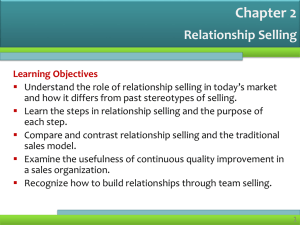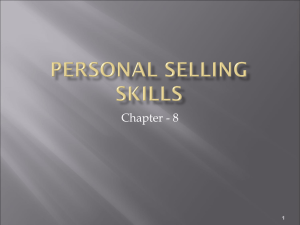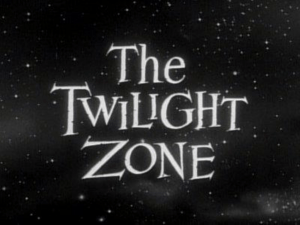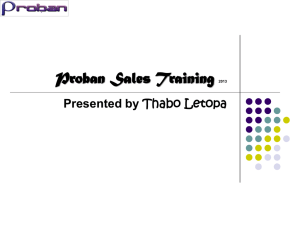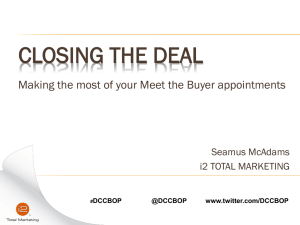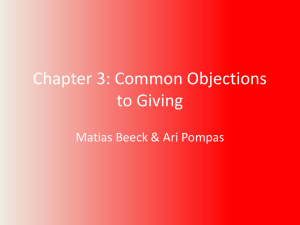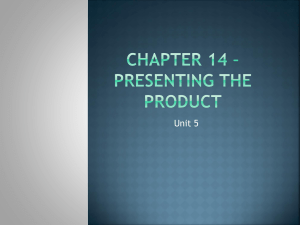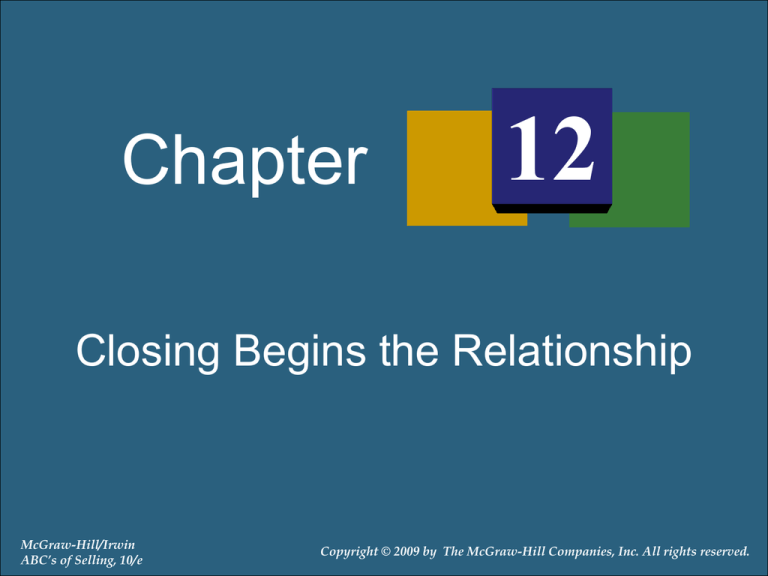
Chapter
12
Closing Begins the Relationship
McGraw-Hill/Irwin
ABC’s of Selling, 10/e
Copyright © 2009 by The McGraw-Hill Companies, Inc. All rights reserved.
Main Topics
When Should I Pop the Question?
Reading Buying Signals
What Makes a Good Closer?
How Many Times Should You Close?
Closing Under Fire
Difficulties With Closing
Essentials of Closing Sales
Prepare Several Closing Techniques
Prepare a Multiple-Close Sequence
12-2
Main Topics, cont...
Close Based on the Situation
Research Reinforces These Sales Success
Strategies
Keys to Improved Selling
The Business Proposition and the Close
Closing Begins the Relationship
When You Do Not Make the Sale
12-3
The Tree of Business Life:
Closing
T
T T
T T TT
T T T T
Builds
Guided by The Golden
Rule:
Relationships
Look for buying signals
Be confident in your suggested
order
Prepare several closes for each
call
Do not take “No” personally
Remember that a successful
close begins your relationship
You now prove your value with
ethical service and your new
relationship
12-4
When Should I Pop the Question?
Closing is the process of helping people make a
decision that will benefit them
There are no magic phrases and techniques to
use in closing a sale
Close when the prospect is in the conviction stage
of the mental buying process
12-5
Exhibit 12-1: Close When the
Prospect is Ready
12-6
When is it time to close?
Close When the Prospect Is Ready
12-7
Reading Buying Signals
A buying signal is anything that a prospect says or
does to indicate that he is ready to buy
Asking questions
Asking another person’s opinion
Relaxing and becoming friendly
Pulling out a purchase order form
Carefully examining merchandise
12-8
Exhibit 12-2: Answering a Prospect’s
Buying Signal Question with a Question
12-9
What Makes a Good Closer?
A good closer:
Asks for the order and then remains quiet
Gets the order and moves on!
12-10
Exhibit 12-3: The Moving Selling
Process
A positive response to
the trial close indicates a
move toward the close.
A negative response
means return to your
presentation or determine
the prospect’s objections.
12-11
What Makes a Good Closer?
Have strong desire to close each sale
Have positive attitude
Know their customers
Tailor presentations to meet each one’s specific
needs
Spend time preparing
Are alert
ABC
Do not stop on first “no”
12-12
What Makes a Good Closer?
Ask for the order, and…be quiet (Shhhhhh)!
Must put prospect in position of having to:
Make a decision
Speak first
Respond to the close
Get the order, and…move on
Continuing to talk, may give
information that changes
buyer’s mind
12-13
How Many Times Should You Close?
You must be able to use multiple closes.
Three
___________closes
is a minimum.
to Five
You will learn how without being pushy
1? 2? 3?
12-14
Closing Under Fire
The first “no” from the prospect isn’t necessarily
an absolute refusal to buy.
12-15
Closing Under Fire
You must be able to ask a prospect, who
may be in a bad mood or may appear
hostile toward you, to buy
12-16
Difficulties With Closing
Closing is the easiest part of the presentation
Salespeople may fail to close because:
They are not confident in their abilities to close
They determine that the prospect does not need the
quantity or type of merchandise or that the prospect
should not buy
They may not have worked hard enough to develop a
customer profile and customer benefit plan
12-17
Essentials of Closing Sales
Be sure your prospect understands what you say
Always present a complete story to ensure
understanding
Tailor your close to each prospect
Everything you do and say should consider the
customer’s point of view
Never stop at the first “no”
Learn to recognize buying signals
12-18
Essentials of Closing Sales, cont…
Before you close, attempt a trial close
After asking for the order, be silent
Set high goals for yourself and develop a personal
commitment to reach your goals
Develop and maintain a positive, confident, and
enthusiastic attitude toward yourself, your
products, your prospects, and your close
12-19
Exhibit 12-5: Twelve Keys to a
Successful Closing
12-20
Prepare Several Closing
Techniques, cont…
The alternative-choice close is an old favorite.
The assumptive close assumes the prospect will
buy.
The compliment close inflates the ego.
The summary-of-benefits close is most popular.
The continuous-yes close generates positive
responses
The minor-points close is not threatening.
The T-account or balance sheet close was Ben
Franklin’s favorite.
12-21
Prepare Several Closing
Techniques, cont…
The standing-room-only close gets action
The probability close
The negotiation close
The technology close
0-50%?
50-85%?
85-100%?
12-22
Exhibit 12-7: Techniques for Closing the
Sale: Which Close Should be Used?
12-23
Prepare Several Closing Techniques
1. Alternative Close – is an old favorite
12-24
Example: The Alternative-Choice
Close is an Old Favorite
“Would you prefer the Xerox 6200 or 6400 copier?”
Study this question – it assumes:
The customer has a desire to buy one of the copiers
The customer will buy
It allows the customer a preference
It provides a choice between products, not
between a product and nothing
By presenting a choice, you receive a “yes”
decision or uncover objections
12-25
“Would you prefer the Xerox 6200 or
6400 copier?”
“I’m not sure,” says the customer (still in the desire
stage)
Continue with your FABs
12-26
“Would you prefer the Xerox 6200 or
6400 copier?”
If you see the customer likes both 6200 and 6400
and appears indecisive, you can ask:
“Is there something you are unsure of?”
This question probes to find out why your prospect
is not ready to choose
12-27
Prepare Several Closing Techniques
2. Assumptive Close – assumes the prospect
will buy
2.
“I’ll call your order in tonight.”, or “I’ll have it shipped to
you tomorrow.”
3. Compliment Close – by complimenting them,
you get them to listen and respond favorably to
your presentation
12-28
Prepare Several Closing Techniques
4.
Summary of Benefits Close – summarize the
product’s benefits in a positive manner so that the prospect
agrees with what you are saying; then ask for the order
1. Three basic steps
2. Determine key benefits that interest prospect during
presentation
3. Summarize these benefits
4. Make a proposal
5.
Continuous-yes Close – like summary close; instead of
summarizing benefits, develop a series of benefit questions
which prospect must answer
12-29
Prepare Several Closing Techniques
6. Minor-points Close – similar to alternative choice
close; except it asks prospect to make a low-risk decision on
a minor, usually low-cost element of a single product such
as delivery dates, optimal features, etc.
7. T-account or Balance Sheet Close – based on the
process people go through when making a decision;
weighing cons against pros. Same as debit and credits, act
or no act, etc. Modified T – only lists reasons to buy
(Continuous.
8. Standing Room Only Close – indicate if they do not
act now, they may not be able to buy in the future – should
only be used in complete honesty
12-30
Prepare Several Closing Techniques
9. Probability Close – ask prospects who are delaying
what the probability of doing business at a later time is.
This permits prospects to focus on and discover own
hidden objections.
Three categories of prospect’s response
1.
More than 50% but less than 85% for buying
2.
More than 85% but less than 100% for buying
3.
Les than 50% for buying
12-31
Prepare Several Closing Techniques
10. Negotiation Close – finds ways for everyone to
have a fair share
11. Technology Close – incorporates appropriate
technology to close sale.
12-32
There are Eleven Closing Techniques in
This Chapter, Each:
Is different
Can be used with other closing techniques
Helps you be a better communicator
Helps you better serve others
Should be carefully studied
12-33
If You Close and Receive an
Objection, What Should You Do?
Find out what the objection is.
12-34
After You Find Out What the Objection Is
and Answer It, What Should You Do Next?
Ask a trial close to determine if you have
overcome the objection.
12-35
If You Have Closed, Had an Objection Arise and
Effectively Handled the Objection, What Should You
Do Next?
Close again!
This is why you need a multiple-closing
sequence.
12-36
Prepare a Multiple-Close Sequence
Different closing techniques work best for
certain situations.
Multiple closes incorporate techniques for
overcoming objections.
12-37
Prepare a Multiple-Close Sequence,
cont…
Keeping several closes ready puts you in a better
position to close more sales.
For Example:
You could begin with a summary-of-benefits close.
If the buyer says no, rephrase the objection and then
use an alternative-choice close.
If the buyer says no again and does not give a reason,
you could use the five-question sequence method for
overcoming objections.
12-38
Exhibit 12-9: Multiple Closes Incorporating
Techniques for Overcoming Objections
12-39
Exhibit 12-9: Multiple Closes Incorporating
Techniques for Overcoming Objections, cont…
12-40
Close Based on the Situation
Different closing techniques work best for certain
situations
Customer is indecisive
Customer is an expert or egotistical
Customer is hostile
Customer is a friend
Customer has predetermined beliefs
Customer is greedy, wants a deal
12-41
Exhibit 12-10: Examples of Closing
Techniques Based on Situations
12-42
Research Reinforces These Sales
Success Strategies
Common salesperson mistakes resulting in
unsuccessful sales calls
Tells instead of sells, doesn’t ask enough questions
Over-controls the call, asks too many closed-end
questions
Doesn’t respond to customer needs with benefits
Doesn’t recognize needs, gives benefits prematurely
Doesn’t recognize or handle negative attitudes
effectively
Makes weak closing statements, doesn’t recognize when
or how to close
12-43
Keys to Improved Selling
Ask questions to gather information and uncover
needs
Recognize when a customer has a real need and
how the benefits of the product or service can
satisfy it
Establish a balanced dialogue with customers
Recognize and handle negative customer attitudes
promptly and directly
Use a benefit summary and an action plan
requiring commitment when closing
12-44
The Business Proposition and the
Close
For some salespeople, the discussion of the
business proposition provides an excellent
opportunity to close.
The Business Proposition
Chap 5 – costs, markups, ROI, etc.
Follows FABs and Marketing Plan
Use a visual aid to close
Visual aids work well for both discussing
the business proposition and closing.
Visual aid to close
12-45
Closing Begins the Relationship
When you make a sale for the first time, you
change the person or organization from a prospect
to a customer.
Follow the Golden Rule in order to earn the
opportunity to sell to the customer in the future.
12-46
The Last Key to Successful Closing is to “Leave the Door
Open. Act as a Professional.” How Can That Be Done?
Always place the customer’s needs first
Treat a customer as you would your grandmother
Be a person of character, integrity, and
trustworthiness
If your product will help the person, then you will
be back another day
12-47
There are Eleven Closing Techniques
in This Chapter, Each:
Is different
Can be used with other closing techniques
Helps you be a better communicator
Helps you better serve others
Should be carefully studied
12-48
Which Closing Technique Should I Use?
To answer that question you should first:
Determine your approach
Create your presentation, then
Determine how best to close
12-49
Assume You Have Completed Your Presentation
and are Getting Ready to Close
You remember to use a trial close before you ask
the person to buy – if objections or questions
arise, what phase of the prospect’s mental steps is
the buyer probably in? (Choose one)
Attention
Interest
Desire
Conviction
Purchase
12-50
Assume You Have Completed Your Presentation
and are Getting Ready to Close, cont…
The buyer is in the desire stage
Which stage should the buyer be in before you
close? (Choose One)
Attention
Interest
Desire
Conviction
Purchase
12-51
Assume You Have Completed Your Presentation
and are Getting Ready to Close, cont…
Ideally, the salesperson should wait for signs that
the person is in the conviction stage because a
buyer in this stage typically:
Has a strong conviction that you can be trusted
Feels the product will fulfill needs or solve problems
Will reveal real concerns due to trust
12-52
Closing Begins the Relationship
When you make a sale, you change the
person or organization from a prospect to a
customer.
You have helped the customer
Now, how do you earn the opportunity to
sell the customer in the future?
Make sure you have followed the Golden Rule in
selling the correct product and providing exceptional
service
12-53
When You Do Not Make the Sale,
Exhibit 12-12
Know that you
cannot always
sell everyone.
Don’t take buyer’s
denial personally.
Be courteous and
cheerful.
12-54
When You Do Not Make the Sale,
Exhibit 12-12
Act as a
professional
An adult salesperson
Leave the door
open.
12-55
If After Your Presentation You Received a Positive
Response to Your Trial Close, What Would You Do?
Approach
Presentation
Trial Close
Determine Objections
Meet Objections
Trial Close
Close
12-56
If After Your Presentation You Received a Negative
Response to Your Trial Close, What Would You Do?
Approach
Presentation
Trial Close
Determine Objections
Meet Objections
Trial Close
Close
12-57
If After You Meet the Objection You Received a Positive
Response to Your Trial Close, What Would You Do?
Approach
Presentation
Trial Close
Determine Objections
Meet Objections
Trial Close
Close
12-58
If After You Meet the Objection You Received a Negative
Response to Your Trial Close, What Would You Do?
Approach
Presentation
Trial Close
Determine Objections
Meet Objections
Trial Close
Close
12-59
If After You Close You Receive a Negative Response,
What Would You Do?
Approach
Presentation
Trial Close
Determine Objections
Meet Objections
Trial Close
Close
12-60
Summary of Major Selling Issues
Be prepared to logically and clearly respond to your
prospect’s objections
Basic points to consider in meeting objections
Plan for them
Anticipate them
Handle them as they arise
Listen to what is said
Respond warmly and positively
Make sure you understand
Respond using an effective communication technique
12-61
Summary of Major Selling Issues,
cont…
Objections are classified as hidden, stalling, noneed, money, product, and source
Objections help you determine if you are on the
right track to uncover prospects’ needs and if they
believe your product will fulfill those needs
Objections show inadequacies in a salesperson’s
presentation or product knowledge
Closing is the process of helping people make
decisions that will benefit them
Constantly look and listen for buying signals from
your prospect
12-62
Summary of Major Selling Issues,
cont…
Tailor your close to each prospect’s personality
Close in a positive, confident, and enthusiastic
manner
Plan and rehearse closing techniques
A good closer has a strong desire to close each
sale
Stay cool, determine any objections, try to close
again
You can’t make a sale until you ask for the order!
12-63

